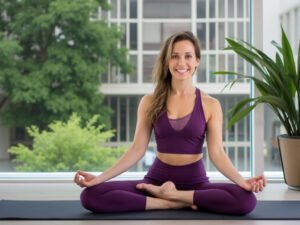Nightfall, also known as nocturnal emission or wet dreams, is a natural physiological process where men experience involuntary ejaculation during sleep. It often occurs during puberty, but it can continue into adulthood in some cases. Although nightfall is generally considered normal and harmless, it may become a concern for some individuals when it happens too frequently or starts affecting their physical and mental well-being.
One of the most effective, natural ways to manage frequent nightfall is through yoga. Yoga offers a holistic approach to addressing this issue by reducing stress, improving self-control, and enhancing physical and mental health. This article explores how yoga can help with nightfall and the specific yoga postures and techniques that can benefit individuals struggling with this condition.
Understanding Nightfall: Causes and Concerns
Before diving into how yoga can help with nightfall, it’s essential to understand what causes this condition. Nightfall primarily occurs due to hormonal changes, particularly an increase in testosterone levels in young men during adolescence. During REM (Rapid Eye Movement) sleep, the brain may trigger sexual arousal, leading to ejaculation without conscious control.
While nightfall is normal, some men experience it frequently, which can lead to feelings of guilt, embarrassment, or anxiety. In such cases, frequent nightfall can disrupt sleep patterns, reduce energy levels, and affect emotional health. Here’s where yoga can play a transformative role.
How Yoga Helps Manage Nightfall
Yoga is not just about physical flexibility; it’s a practice that combines physical postures (asanas), breathing exercises (pranayama), and meditation to promote balance and harmony between the body and mind. Here’s how yoga can help with nightfall:
- Reduces Stress and Anxiety: Stress is one of the most common triggers of frequent nightfall. Yoga helps calm the mind, reduce stress levels, and enhance emotional resilience through deep breathing and meditation. This can alleviate the mental tension that contributes to nightfall.
- Improves Hormonal Balance: Certain yoga asanas are known to regulate the endocrine system, which helps maintain healthy hormone levels. This is especially beneficial for managing testosterone levels and reducing the frequency of nightfall.
- Increases Self-Control and Discipline: Yoga teaches mindfulness and self-awareness, helping individuals gain control over their thoughts and emotions. By practicing yoga regularly, individuals can cultivate the discipline needed to manage sexual impulses that might contribute to frequent nightfall.
- Enhances Quality of Sleep: Yoga promotes relaxation, which is vital for achieving deep, restorative sleep. By improving the quality of sleep, yoga can help reduce the chances of nocturnal emissions, which often occur during restless or disturbed sleep.
- Boosts Energy and Vitality: Frequent nightfall can lead to fatigue and reduced energy levels. Yoga helps increase vitality by improving blood circulation, oxygenating the body, and rejuvenating the nervous system.
Top 7 Yoga Poses to Help with Nightfall
Certain yoga poses are particularly effective in managing nightfall by improving self-control, reducing stress, and enhancing physical well-being. Here are the top seven yoga asanas that can help:
1. Sarvangasana (Shoulder Stand)
Sarvangasana is a powerful yoga pose that stimulates the thyroid and parathyroid glands, helping regulate hormone levels in the body. It also improves blood circulation and enhances mental clarity, promoting overall relaxation.
How to Perform:
- Lie on your back and lift your legs straight up.
- Support your back with your hands, raising your legs and torso into a straight line.
- Hold the pose for 30 seconds to 1 minute, breathing deeply.
Benefits:
- Balances hormones
- Relieves stress
- Promotes restful sleep
2. Dhanurasana (Bow Pose)
This back-bending pose stretches the entire body and stimulates the reproductive organs, helping regulate sexual energy. Dhanurasana also helps improve focus and self-discipline.
How to Perform:
- Lie on your stomach and bend your knees.
- Reach back to hold your ankles and lift your chest and legs off the ground.
- Hold the pose for 20-30 seconds while breathing deeply.
Benefits:
- Strengthens the reproductive system
- Improves emotional control
- Enhances energy levels
3. Baddha Konasana (Bound Angle Pose)
Baddha Konasana helps stretch the inner thighs and groin area, promoting blood flow to the reproductive organs. It’s a calming pose that helps relieve stress and anxiety, reducing the chances of nightfall.
How to Perform:
- Sit with your legs stretched out in front of you.
- Bend your knees and bring your feet together, holding your toes with your hands.
- Gently press your knees towards the floor and hold the pose for 1-2 minutes.
Benefits:
- Reduces stress and anxiety
- Improves flexibility in the pelvic region
- Promotes mental relaxation
4. Viparita Karani (Legs-Up-the-Wall Pose)
This restorative pose helps calm the nervous system and promote relaxation. Viparita Karani is excellent for relieving tension and encouraging deep sleep, which can help reduce the frequency of nightfall.
How to Perform:
- Lie on your back near a wall and extend your legs up the wall.
- Relax your arms by your sides and close your eyes.
- Hold the pose for 5-10 minutes, breathing deeply.
Benefits:
- Calms the mind
- Relieves fatigue and anxiety
- Improves sleep quality
5. Padmasana (Lotus Pose)
Padmasana is a meditative pose that helps improve concentration and control over sexual energy. It’s often used for pranayama (breathing exercises) and meditation, which are essential for managing the mental aspects of nightfall.
How to Perform:
- Sit on the floor with your legs crossed and feet resting on opposite thighs.
- Keep your back straight and hands on your knees in a relaxed position.
- Focus on your breathing and hold the pose for 5-10 minutes.
Benefits:
- Enhances mental focus
- Improves self-control
- Reduces stress
6. Setu Bandhasana (Bridge Pose)
Setu Bandhasana strengthens the pelvic muscles and improves circulation to the reproductive organs. It also helps alleviate anxiety and stress, which are common contributors to nightfall.
How to Perform:
- Lie on your back with your knees bent and feet flat on the floor.
- Lift your hips towards the ceiling while pressing your feet into the floor.
- Hold the pose for 30-60 seconds, breathing deeply.
Benefits:
- Strengthens pelvic muscles
- Relieves tension and anxiety
- Improves overall circulation
7. Shavasana (Corpse Pose)
Shavasana is a deeply relaxing pose that helps reduce stress and promotes mental clarity. It’s often practiced at the end of a yoga session to calm the body and mind, making it easier to sleep peacefully.
How to Perform:
- Lie on your back with your arms and legs relaxed.
- Close your eyes and focus on your breathing.
- Stay in the pose for 5-10 minutes, allowing your body to completely relax.
Benefits:
- Promotes deep relaxation
- Reduces stress and anxiety
- Improves sleep quality
Pranayama for Nightfall Management
In addition to yoga asanas, pranayama (breathing exercises) plays a crucial role in managing nightfall. Deep breathing exercises help calm the mind, reduce stress, and improve focus. Here are two pranayama techniques that are particularly beneficial:
1. Anulom Vilom (Alternate Nostril Breathing)
This pranayama technique helps balance the nervous system and reduce anxiety, which is essential for controlling the triggers of frequent nightfall.
How to Perform:
- Sit in a comfortable position and close your right nostril with your thumb.
- Inhale through the left nostril, then close the left nostril with your ring finger and exhale through the right.
- Continue the alternate breathing for 5-10 minutes.
2. Bhramari (Bee Breath)
Bhramari is a calming pranayama technique that helps reduce mental stress and anxiety, promoting deep relaxation and better sleep.
How to Perform:
- Sit comfortably and close your eyes.
- Inhale deeply and, as you exhale, make a humming sound like a bee.
- Repeat this for 5-7 rounds.
Lifestyle Tips to Complement Yoga for Nightfall
While yoga is a powerful tool for managing nightfall, it’s also important to make lifestyle changes that complement your practice. Here are a few tips:
- Maintain a Balanced Diet: Eat nutrient-rich foods that support hormonal balance and overall health.
- Stay Hydrated: Drink plenty of water to help flush toxins from your body.
- Limit Stimulants: Reduce your intake of caffeine, nicotine, and other stimulants that can interfere with sleep and increase anxiety.
- Avoid Sexual Content: Limit exposure to sexually explicit material, which can increase the chances of nightfall.
- Practice Meditation: Incorporate regular meditation into your routine to help calm the mind and reduce stress.
Conclusion
Yoga offers a holistic and natural approach to managing nightfall by addressing both the physical and mental aspects of the condition. Through regular practice of specific yoga poses, pranayama, and meditation, individuals can reduce stress, improve hormonal balance, and enhance self-control, ultimately minimizing the frequency of nightfall. Combined with a healthy lifestyle, yoga can be an effective solution for those looking to overcome this issue and improve their overall well-being.







